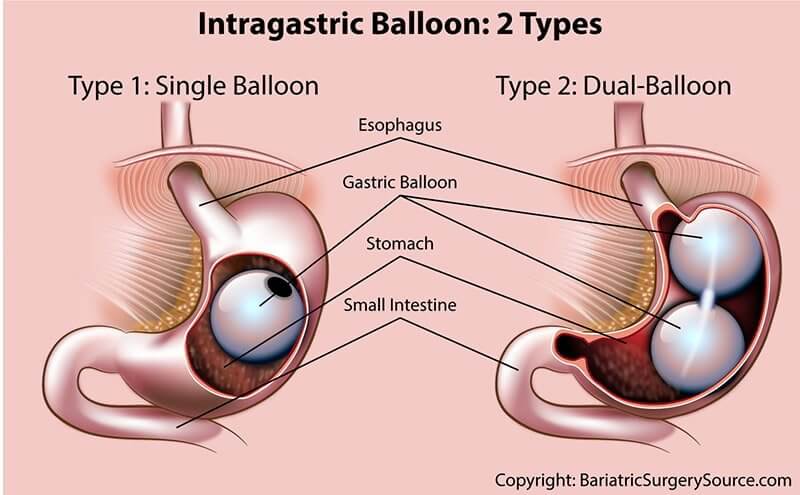The endoscopic intragastric balloon, or gastric balloon, is a relatively new, non-invasive bariatric procedure developed to “bridge the gap” between pure diet and exercise and a more complicated bariatric procedure like gastric sleeve surgery.
This page covers everything you need to determine whether it’s the right weight loss procedure for you…
- How Much Weight Will You Lose?
- How to Qualify
- Costs, Insurance & Financing
- Surgery: Procedure, Preparation, Hospital Stay, Recovery
- Types of Balloons
- Risks and Side Effects
- Diet While Your Balloon Is In Place
- Removal or Replacement of the Balloon
- Ask the Surgeon or Share Your Experiences
- Find a Gastric Balloon Surgeon
Gastric Balloon: How Much Weight Will You Lose?
As long as the gastric balloon is used together with other effective measures like a strong diet and exercise program, it has been shown to be an effective, if moderate or “starter” weight loss option.
In clinical trials conducted for each type of intragastric balloon, patients lost anywhere from 26% to 46% of their excess weight.
The following section describes how this might be turned into greater weight loss depending on your goals.
Best Candidates for the Balloon
Ensuring a “successful story” following gastric balloon surgery will depend on your goals.
Let’s start with a hypothetical example patient:
- Current body mass index (BMI) of 37 (5’9″ tall and 250 pounds)
- Weight loss goal is to get BMI to 25 (170 pounds).
- A 36% reduction in excess body weight (halfway between the 26% and 46% reported in clinical trials for each balloon type) would only get the patient to a BMI of 32.6 (221 pounds), a weight classification of "obese"
So what are more realistic goals?
Goal #1: Qualify for a More Aggressive Weight Loss Surgery Procedure
More aggressive weight loss surgery procedures like gastric sleeve, gastric bypass, or gastric banding are safer when you weigh less going into surgery. Losing 7% to 10% of your body weight before a more aggressive procedure will significantly reduce your risk of complications.
Click here to learn more about the more aggressive bariatric surgery procedures.
Goal #2: Lose a Moderate Amount of Weight Quickly to “Jump Start” a Longer-Term Diet and Exercise Program
If diet and exercise programs have continually failed but you are unwilling or unable to commit to full bariatric surgery, the intragastric balloon may be a good short-term or “starter” option.
While some patients use the balloon to drop their weight for an important one time event, like a wedding, patients serious about long-term weight loss use it to jump-start a more aggressive diet and exercise program.
Either way, most balloons are only safe for up to 6 months, so it should not be considered a permanent fix.
How to Qualify for a Gastric Balloon
In order to qualify, patients must satisfy 2 requirements:
- For some types of balloons such as the ReShape Balloon, you must have a health risk associated with obesity (also known as a "comorbidity") like diabetes, high blood pressure or sleep apnea. For other ballon types like the Orbera balloon, no comorbidities are required.
Have a BMI in the following ranges by country:
Use the BMI calculator below to determine your BMI…
Gastric Balloon Insurance, Cost & Financing Around the World
Gastric Balloon Insurance
While approved for use in most countries including the United States, Canada, Australia and the United Kindom, the intragastric balloon is not typically covered by insurance other than in the UK.
In the United States, most insurance policies, including those from Medicare and most major insurance companies, specifically exclude the intragastric balloon from coverage because it has not been around long enough. For example, Medicare states it is not covered because "the long term safety and efficacy of the device in the treatment of obesity has not been established."
In Australia, your Health Fund may cover part of the procedure (such as the gastroscopy) but will probably not cover the majority of the costs.
Canada’s national health insurance program does not cover it.
In the UK, the National Health Service (NHS) may cover the procedure if you can prove that your weight is impacting your health to a large enough degree. This determination is made on a case-by-case basis which may take several months.
Balloon Price by Country
Following are the results of our annual gastric balloon price survey by country:
- United States:
- Average Cost: $8,150 US Dollars
- Range: $6,000 to $10,000 US Dollars
- Australia:
- Average Cost: $5,825 Australian Dollars ($4,178 US Dollars)
- Range: $4,150 – $7,500 Australian Dollars ($2,976- $5,379 US Dollars)10
- Canada:
- Average Cost: $10,943 Canadian Dollars ($8,250 US Dollars)
- Range: $10,600 to $11,280 Canadian Dollars ($8,000 to $8,500 US Dollars)9
- Mexico:
- Average Cost: $5,800 US Dollars8
- United Kingdom:
- Average Cost: £4,000 ($6,195 US Dollars)
- Range: £3,750 to £4,250 ( $5,800 – $6,590 US Dollars)
For an exact price, click here to jump down to the list of surgeons who currently offer it and contact them directly.
Most practices offer financing to make the procedure more affordable. Contact a practice in your desired area to learn about your options.
Gastric Balloon Procedure, Hospital Stay and Recovery
The gastric balloon procedure is one of the quickest and simplest bariatric procedures, usually involving a minimal amount of time in the hospital. This section will go over…
How the Procedure is Performed
Once you are set up in the treatment room, the procedure usually begins with your throat being numbed by a spray. The numbing sensation may feel strange, but it will help your throat tolerate the instruments used in the procedure.
If you wish, you can also ask for an injection to make you feel sleepy, but these options will be discussed with you beforehand.
After you are comfortable, the nurse will insert a plastic mouth guard between your teeth to keep your mouth open for the scope. The scope will then be passed through your mouth and into your stomach. This will not be painful and you will be able to breath without worry.
The doctor may also need to pass some air down the scope to have a clear view. This too can be a strange feeling and it may make you want to belch.
The scope will then be removed, the balloon passed into your stomach, and then inflated with either air or saline solution.
Finally, the scope will be passed into your stomach one final time to double check the balloon is in the right position and properly inflated.

Preparing for Surgery
Your surgeon and their office will work closely with you to prepare for surgery. You will probably have a pre-procedure health assessment, where you will be asked questions about your medical history and medications. You will also be asked about your surgical history as some complications can arise if you’ve had prior procedures on your stomach. Your surgeon may order certain tests like an ECG, x-ray, and blood tests.
In preparing for your day of the procedure, it is very important to follow your doctor’s instructions exactly. Among other things, your doctor will probably ask you to fast for 12 hours.
The Day of the Procedure
The balloon procedure is much less complicated than the more aggressive weight loss surgery options. For example, gastric sleeve surgery, the least complicated of the more aggressive options, takes about 2 hours of surgery time and about 2 to 3 days in the hospital to recover.
The procedure takes no more than a half hour, and most patients are out of the hospital on the same day.
Recovery
The typical balloon patient returns home on the same day. It is recommended that you have someone who is willing and able to drive you home and take care of you for at least 24 hours following surgery. Also, plan about 3 days of inactivity for full recovery.
Your throat will probably be sore following the procedure since the balloon was inserted through your mouth.
Types of Intragastric Balloons
There are 4 widely accepted types of intragastric balloons, each with their own slightly different characteristics. We have summarized the main differences in the table below…
Procedure Videos Procedure Videos |
Features Features |
Qualifications Qualifications |
InsertionM InsertionM |
Removal Removal |
Availability Availability |
Effectiveness Effectiveness |
Safety Safety |
Features Single silicon balloon (450 – 700 ml) Filled with saline and methylene blue dyeL |
Qualifications A BMI greater than 30 in the US and 27 in most other countries |
InsertionM Endoscopically |
Removal After 6 monthsK |
Availability United States – FDA approved in 2015B European Union – CE mark certified in 1997C Canada and Mexico Australia United Kingdom Also several other European and South American countries |
Effectiveness Patients initially lost on average 26.5% of their excess weight 3 months after removal of the balloonH |
Safety 33.7% of patients experienced pain and nausea, which in most cases was easily managed 7.5% of patients needed early removal because of complications 0.1% experienced gastric perforationK |
Features Two connected silicon balloons ("dual balloon") (450 ml each). Filled with saline and methylene blue dyeL |
Qualifications A BMI greater than 30 and a diagnosed comorbdidity in the US; a BMI of greater than 27 in most other countries. |
InsertionM Endoscopically |
Removal After 6 monthsK |
Availability United States – FDA approved in 2015D Available in the European Union – CE mark certified in 2007E Specifically available in the United Kingdom, Spain, and Italy |
Effectiveness Patients lost 31.8% of their excess weight and kept ⅔ of that weight loss 6 months after balloon removalK |
Safety Many patients experienced nausea or vomiting, which in most cases was easily managed About 9% of patients had early removal of the balloon because of intolerance About 10% of patients experience ulcersK |
Features Single adjustable silicon balloon Filled solely with saline solutionL |
Qualifications Either 1) Ten kg or more to lose, 2) a BMI greater than 27, or 3) you are unable to have surgery for some reason |
InsertionM Endoscopically |
Removal After 12 monthsA |
Availability Not FDA approved European Union – CE mark certified in 2012F Specifically available in Australia, the United Kingdom, India, and many other countries in Europe, South America, and the Middle East |
Effectiveness Patients lost 46% of their excess weightK |
Safety Unfortunately there has not been much study into the safety of the Spatz Balloon SystemK There was anecdotal evidence that a previous version of the Spatz had a design flaw that has since been corrected with the Spatz3 systemL |
Features Swallowable gelatin encased capsule (250 ml) Single balloon filled endoscopically with Nitrogen GasL |
Qualifications A BMI greater than 27 |
InsertionM Swallowing with x-ray monitoring |
Removal After 3 monthsK |
Availability Not FDA approved European Union – CE mark certified in 2012G Specifically available in the United Kingdom, Austria, Belgium, Italy, Luxembourg, Netherlands, and Spain |
Effectiveness In a very small study, 17 patients lost on average 36.2% of their excess weightI |
Safety In one study 43 of 44 balloons were swallowed without incident and only two were eventually removed due to patient discomfortJ |
Risks and Side Effects
The intragastric balloon is relatively low risk and issue free. However, as with any medical procedure, there are potential risks and side effects to be aware of and you should discuss with your doctor for details specific to your situation…
Intragastric Balloon Contraindications
The balloon is not recommended for patients with any of the following:
- Prior gastrointestinal surgery with sequelae (an abnormal condition related to the surgery)
- Prior open or laparoscopic bariatric surgery
- Inflammatory diseases of the GI tract
- Potential upper GI bleeding
- Any medical condition that would not permit endoscopy
It is also not recommended for patients who:
- Have alcohol or drug addictions
- Receive daily prescribed treatment with aspirin, anti-inflammatory agents, anticoagulants or other gastric irritants
- Currently are or may be pregnant or breast-feeding
- Are not willing to participate in a medically-supervised diet and behavior modification program
Gastric Balloon Complications & Risks
As with any surgery, there is a possibility that complication will arise. The most common associated with the balloon include…
- Risks associated with any endoscopic procedure and sedation (being "put to sleep")
- Punctured Esophagus: Because the surgeon uses a scope when performing the procedure, there is a slight chance that the scope could puncture the esophagus. However, this is very rare, with one practice saying that in the several hundred procedures they have performed, they have never encountered the problem6.
- Stomach Blockage: It is possible for the balloon to deflate in the stomach and cause a blockage. This is why one system, the ReShape Integrated Dual Balloon System has two, independent balloons – if one deflates the other will keep the entire apparatus in the stomach. Most balloons are also filled with a dye designed to turn your urine an unusual color (like blue or green) so you know to alert your surgeon if there is an issue with your balloon.
- Stomach Ulcer or Rupture: To reduce the risk of an ulcer your surgeon will most likely prescribe anti-ulcer medication for the entire time the balloon is in your stomach. Stomach rupture is extremely rare, and usually will only happen if you have already had some kind of stomach surgery, which means that most surgeons you speak with will most likely not be willing to perform the procedure if you have already undergone another stomach procedure9.
If, in the middle of the procedure, the surgeon discovers an ulcer or a very large hiatus hernia, the procedure will be ended prematurely by the surgeon for safety reasons.
Gastric Balloon Side Effects
Because your stomach will be readjusting to the presence of the balloon, in the first couple weeks after the procedure you will probably experience cramps, nausea, and possibly vomiting.
Some people also report feeling bloated. Most likely this is from the balloon, however, if you are concerned speak to your surgeon’s office. Don’t let this feeling discourage you, the feeling is probably an indication that the balloon is doing its job.
You must also adjust your eating and drinking habits somewhat, which some patients report difficulty with…
Diet While Your Gastric Balloon Is In Place
For a couple weeks or so after your surgery you will be on a liquids and soft-food-only diet. After this, you will need to permanently adjust your diet to reinforce and maintain your weight loss.
Day 1 – Clear Liquids Only
In the first 24 hours you should only drink clear liquids. We would recommend you drink…
- Water
- Broth
- Ice Chips
- Crystal Light
- Propel Fitness Water (Zero Calorie only)
- Powerade (Zero Calorie only)
There are a couple important things here to remember…
- We advise if at all possible you drink warm liquids over cold liquids
- Do NOT drink carbonated drinks – these will cause gas and bloating
- Drink at least 8 cups of liquid per day. This keeps you hydrated and prevents constipation
- Start by taking small sips. Wait a minute or two between sips, and try and increase the amount you sip as you get more comfortable. You should sip no more than ⅓ of a cup at a time
- Sit upright after drinking, allowing gravity to help your system. If you are resting, use a recliner rather than lying flat
- Do not drink more than one cup of coffee or caffeine drink per day. Caffeine can cause you to become dehydrated, and it can cause cramping and diarrhea
Day 2 through 7 – Liquid Diet
For days 2 through 7 after surgery you must still maintain a liquid diet, but you can begin to include non-clear liquids. Try to sip about 8 cups (2 liters) a day with no more than 3 – 3.5 ounces (100 ml) in one sitting.
Here are some recommended liquids to help you get all your nutrients…
- Semi-skimmed milk (recommended at least 600 ml a day)
- Low calorie/reduced sugar squash
- Herbal Teas
- Water/Juice mixes
- Clear beef or chicken broth soup
- Any protein drinks recommended by your surgeon
Day 7 through 14 – Pureed Food Diet
About a week after surgery you should switch to a pureed food diet. Your doctor will work with you regarding the exact timing and what foods you should be eating.
But, it will likely consist of lean protein foods, such as fish, poultry, eggs, cheese, or healthier dairy and soy products. This should always been accompanied by high ratios of fruits and vegetables.
Your New Normal

After your body has gotten used to the balloon you can resume a mostly normal diet, with a few restrictions…
Most importantly, follow your dietitian or nutritionist’s instructions to the letter, including any vitamin or mineral regimen.
- To reduce the risk of vomiting, sip water after you eat any food to wash off the balloon. If you do vomit, give your stomach some time to rest – consider going back to a pureed diet for a couple of days. Also, no pasta. Pasta tends to stick to the balloon, increasing your chances of vomiting12.
Removal or Replacement of the Gastric Balloon
The gastric balloon is not designed as a long term fix. Because of the risk of it interfering with your stomach, the balloon is either removed, or sometimes replaced, after anywhere from 12 weeks to 1 year, depending on the type you get. Your surgeon will help coordinate both the insertion and removal procedures.
“After removal, it is recommended you stick with a managed weight loss program, and then maintain your newly established diet for the rest of your life.”
Since it is a temporary, or a “bridge”, treatment for bariatric patients, the balloon procedure is usually used in tandem with a diet and exercise program, or in preparation for an additional bariatric procedure like the gastric sleeve or lap band. A qualified surgeon will help you make the best choice.
Much like before the insertion of the balloon, you will need to fast before removal surgery – no solid foods for 24 hours and no liquids for 12 hours prior to surgery. You will be sedated and the procedure should take about 20 – 30 minutes, very similar to the balloon insertion procedure.
After removal, it is recommended you stick with a managed weight loss program, and then maintain your newly established diet for the rest of your life. Most practices combine the balloon with a lifestyle management program for 6 months after the removal of the balloon. This will ensure you will maintain the weight you lost while the balloon was in place.
It is also possible to have another balloon inserted after removal. However, because the balloon is used in tandem with a diet and exercise program your surgeon will likely ask you to wait a little while to determine whether there are less invasive ways to maintain a healthy weight.
Ask the Experts or Share Your Experiences*
If you still have questions about the gastric balloon, we are happy to answer them. We would also love to hear about your experiences with the balloon.
Use the form below to submit your question or contribution now…
Questions From Other Visitors*
Click below to see contributions from other visitors to this page.
Find a Gastric Balloon Surgeon
Search the gastric balloon surgeon directory below to find a weight loss surgeon by country and region:



